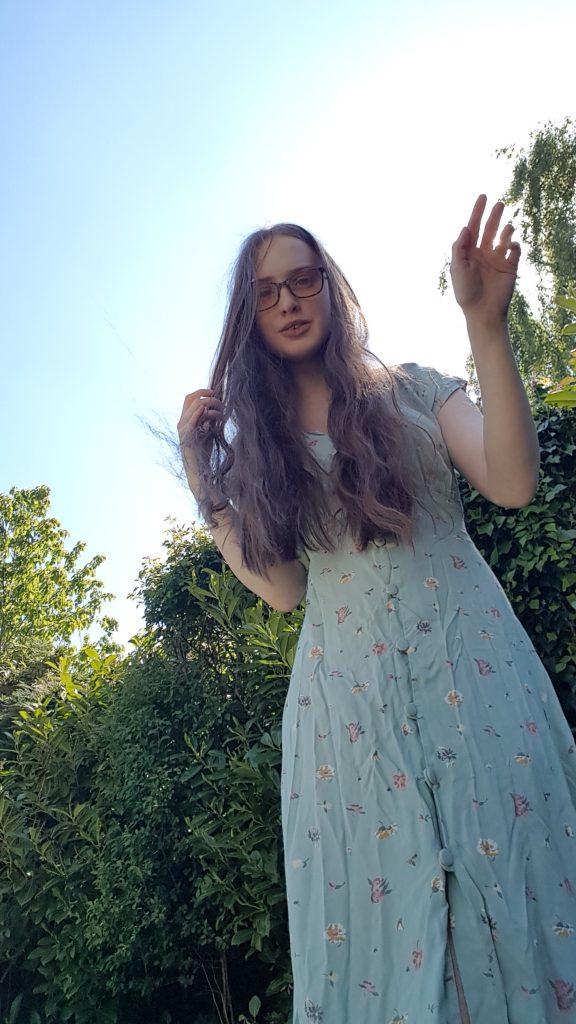
Today I’ll be sharing my investigation into one of my favourite garments. It’s a delicate blue-green summer dress which belonged to my Nanny (grandmother). She gave it to my mother who didn’t wear it, but then… I got hold of it! It’s a few sizes too big for me but lays really nicely, when pulled in gently with the tie at the back. I started calling it my “Miss Honey” recently, it has a certain feeling that reminds me of her character in the film of Matilda.
When I first put this dress on it was like I’d found something I always vaguely imagined and hoped for. It’s one of those things that just feels “me”. I can wear it effortlessly while feeling pretty. Though it’s usually in need of ironing and my mother would just love to have got hold of me before I took these photos last year (the length of my hair is a giveaway about how old these pictures are) and stopped me until she could iron the dress!! … Sorry, mum.
As for it’s history, the label says “Raysil Sample” so my Nanny must’ve been given it by a friend. I’d love to be able to ask her these sorts of things but she’s not here any more.
I did some googling and found no immediately obvious matches for Raysil. I spent some time on the website of an active company selling “viscose fillament yarn”. “For new age royalty. For the woman of today. For you.” apparently. It can also be made to create crepe bandages. But, judging by the photographs which show vibrant, Indian garments, I somehow doubt they had a part in this design. ( This is their website if you’re curious )
I took to typing in “Raysil” followed by a date. 1980s, nothing. Unless you count something about the effects of radiation (which, for the purposes of this post, I don’t). 1990s, again nothing relevant. Then I tried the 1970s and turned up “Raysil Gowns Limited” on a website listing details of registered companies. The first one I clicked asked me to sign in, so I backed out again and searched the company name. Eventually I gathered some information from a few pages: some listed a Manchester address, but the London one feels more likely as that’s where my Nanny lived. It’s also referenced as London based in a book (which I’ll get onto in a moment!). The company was founded on the 9th of November 1970 and dissolved on the 24th of February 2004. So that doesn’t exactly narrow down any guesses at the age of my dress.

Now, I’d been hoping for some more light-hearted, fashion based information to share with you. The last time I researched a vintage dress (for a post which never came to be) I found details of the designer who founded the company, and how the brand’s style changed after he (not so light-heartedly) died and his wife took over. It wasn’t to be this time. Instead I had the small, friendly business picture I’d created in my head well and truly undermined. I found out that Raysil were a subsidiary of a larger company, “Tootal”. By the sounds of it, this was the early days of fast fashion. The book I found on Google, “Women’s Employment and Multinationals in Europe” published in 1989 (apparently I can’t do light-hearted background reading for a blog post no matter how hard I try), describes subcontracting, low wages, poor working conditions and factories subcontracting even further, to poorly paid women working from home. Many of these women were noted to be from ethnic minorities. It’s a story we’re all too familiar with today, though often as something associated with countries that feel far away. Judging by the introduction to this 1989 book, that was the case then as well. Research was conducted into situations in the “third world”, but the same analysis hadn’t been done in Europe.
Raysil acted as a “middleman”, making fashion clothing for C&A, Tesco, Mother Care, BHS (British Home Stores) and others. They did manufacture under their own brand name, but mostly their clothes were sold under the shops’ own labels. Which explains why I wasn’t inundated with ebay listings when searching for Raysil. There could be cousins of my dress sporting C&A or BHS labels, or perhaps nobody placed an order for this design. Maybe it never went beyond the sample stage.
I’m making an uneducated guess that this dress could be early ‘80s. It feels surprisingly modern, probably because they were aiming at the cheap end of the market so the quality is more similar to what we’re used to today. Even so, it’s still good enough that I’d choose this dress over something from today’s fast fashion brands.
If anybody is interested in the book, here is a direct link to the Raysil references, which are fortunately on pages that are available for free. I want to spend time reading more of it, though to be honest there are probably more relevant/contemporary things I would be better off focusing on (can’t help being intrigued…).

Today’s post didn’t turn out how I imagined but it was interesting. Thanks for being here and giving me an excuse to research it. I doubt I would’ve devoted my energy to this if it wasn’t for the credible goal of a blog post. There are just so many things worthy of prioritising that I rarely have much strength left over for anything along these lines. I’m also happy to have used these photographs beyond Instagram. I had no other home for them this time last year. Don’t forget, you can use Bloglovin’ to follow my site by clicking this link (opens in new tab).
Here’s to more posts like this one and more evenings spent accidentally adventuring into a world of ‘80s academic research!
All the best,
-Sakara x

